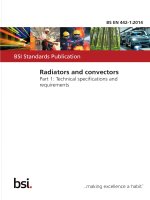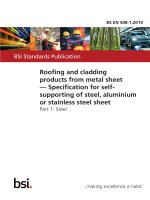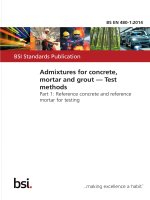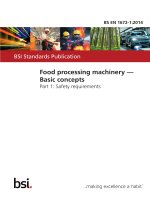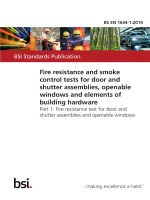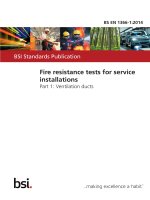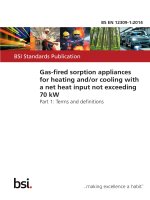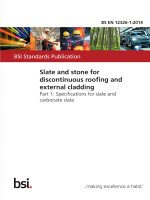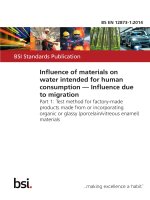Bsi bs en 61858 1 2014
Bạn đang xem bản rút gọn của tài liệu. Xem và tải ngay bản đầy đủ của tài liệu tại đây (2 MB, 38 trang )
BS EN 61858-1:2014
BSI Standards Publication
Electrical insulation systems —
Thermal evaluation of
modifications to an
established electrical
insulation system (EIS)
Part 1: Wire-wound winding EIS
BRITISH STANDARD
BS EN 61858-1:2014
National foreword
This British Standard is the UK implementation of EN 61858-1:2014. It is
identical to IEC 61858-1:2014. It supersedes BS EN 61858:2008 which is
withdrawn.
The UK participation in its preparation was entrusted to Technical
Committee GEL/112, Evaluation and qualification of electrical insulating
materials and systems.
A list of organizations represented on this committee can be obtained on
request to its secretary.
This publication does not purport to include all the necessary provisions of
a contract. Users are responsible for its correct application.
© The British Standards Institution 2014.
Published by BSI Standards Limited 2014
ISBN 978 0 580 81149 4
ICS 29.080.30
Compliance with a British Standard cannot confer immunity from
legal obligations.
This British Standard was published under the authority of the
Standards Policy and Strategy Committee on 31 May 2014.
Amendments/corrigenda issued since publication
Date
Text affected
BS EN 61858-1:2014
EUROPEAN STANDARD
EN 61858-1
NORME EUROPÉENNE
EUROPÄISCHE NORM
May 2014
ICS 29.080.30
Supersedes EN 61858:2008
English Version
Electrical insulation systems - Thermal evaluation of
modifications to an established electrical insulation system (EIS)
- Part 1: Wire-wound winding EIS
(IEC 61858-1:2014)
Systèmes d'isolation électrique - Évaluation thermique des
modifications apportées à un système d'isolation électrique
(SIE) éprouvé - Partie 1: Système d'isolation électrique à
enroulements à fils
(CEI 61858-1:2014)
Elektrische Isoliersysteme - Thermische Bewertung von
Veränderungen an einem erprobten elektrischen
Isoliersystem (EIS) - Teil 1: EIS mit Runddraht-Wicklungen
(IEC 61858-1:2014)
This European Standard was approved by CENELEC on 2014-03-19. CENELEC members are bound to comply with the CEN/CENELEC
Internal Regulations which stipulate the conditions for giving this European Standard the status of a national standard without any alteration.
Up-to-date lists and bibliographical references concerning such national standards may be obtained on application to the CEN-CENELEC
Management Centre or to any CENELEC member.
This European Standard exists in three official versions (English, French, German). A version in any other language made by translation
under the responsibility of a CENELEC member into its own language and notified to the CEN-CENELEC Management Centre has the
same status as the official versions.
CENELEC members are the national electrotechnical committees of Austria, Belgium, Bulgaria, Croatia, Cyprus, the Czech Republic,
Denmark, Estonia, Finland, Former Yugoslav Republic of Macedonia, France, Germany, Greece, Hungary, Iceland, Ireland, Italy, Latvia,
Lithuania, Luxembourg, Malta, the Netherlands, Norway, Poland, Portugal, Romania, Slovakia, Slovenia, Spain, Sweden, Switzerland,
Turkey and the United Kingdom.
European Committee for Electrotechnical Standardization
Comité Européen de Normalisation Electrotechnique
Europäisches Komitee für Elektrotechnische Normung
CEN-CENELEC Management Centre: Avenue Marnix 17, B-1000 Brussels
© 2014 CENELEC All rights of exploitation in any form and by any means reserved worldwide for CENELEC Members.
Ref. No. EN 61858-1:2014 E
BS EN 61858-1:2014
EN 61858-1:2014
-2-
Foreword
The text of document 112/252/CDV, future edition 1 of IEC 61858-1, prepared by IEC/TC 112
"Evaluation and qualification of electrical insulating materials and systems" was submitted to the
IEC-CENELEC parallel vote and approved by CENELEC as EN 61858-1:2014.
The following dates are fixed:
•
latest date by which the document has to be
implemented at national level by
publication of an identical national
standard or by endorsement
(dop)
2014-12-19
•
latest date by which the national
standards conflicting with the
document have to be withdrawn
(dow)
2017-03-19
This document supersedes EN 61858:2008.
EN 61858-1:2014 includes the following significant technical changes with respect to EN 61858:2008:
a)
this part is specifically for wire-wound winding EIS;
b)
new figures and charts support the contents.
Attention is drawn to the possibility that some of the elements of this document may be the subject of
patent rights. CENELEC [and/or CEN] shall not be held responsible for identifying any or all such
patent rights.
Endorsement notice
The text of the International Standard IEC 61858-1:2014 was approved by CENELEC as a European
Standard without any modification.
In the official version, for Bibliography, the following notes have to be added for the standards indicated:
IEC 60034-18-21
NOTE
Harmonized as EN 60034-18-21.
IEC 60317-15
NOTE
Harmonized as EN 60317-15.
BS EN 61858-1:2014
EN 61858-1:2014
-3-
Annex ZA
(normative)
Normative references to international publications
with their corresponding European publications
The following documents, in whole or in part, are normatively referenced in this document and are
indispensable for its application. For dated references, only the edition cited applies. For undated
references, the latest edition of the referenced document (including any amendments) applies.
NOTE 1 When an International Publication has been modified by common modifications, indicated by (mod), the relevant
EN/HD applies.
NOTE 2 Up-to-date information on the latest versions of the European Standards listed in this annex is available here:
www.cenelec.eu
Publication
Year
Title
EN/HD
Year
IEC 60085
2007
Electrical insulation - Thermal evaluation
and designation
EN 60085
-
IEC 60172
-
Test procedure for the determination
of the temperature index of enamelled
winding wires
EN 60172
-
IEC 60216-5
-
Electrical insulating materials - Thermal
endurance properties Part 5: Determination of relative thermal
endurance index (RTE) of an insulating
material
EN 60216-5
-
IEC 60317-1
-
Specifications for particular types of winding wires Part 1: Polyvinyl acetal enamelled round
copper wire, class 105
-
IEC 60317-2
-
Specifications for particular types
EN 60317-2
of winding wires Part 2: Solderable polyurethane enamelled
round copper wire, class 130, with a bonding
layer
-
IEC 60317-3
-
Specifications for particular types of winding wires Part 3: Polyester enamelled round copper
wire, class 155
-
IEC 60317-4
-
Specifications for particular types of winding EN 60317-4
wires Part 4: Solderable polyurethane enamelled
round copper wire, class 130
-
IEC 60317-8
-
Specifications for particular types of winding EN 60317-8
wires - Part 8: Polyesterimide enamelled
round copper wire, class 180
-
IEC 60317-12
-
Specifications for particular types of winding EN 60317-12
wires Part 12: Polyvinyl acetal enamelled round
copper wire, class 120
-
BS EN 61858-1:2014
EN 61858-1:2014
-4-
Publication
Year
Title
IEC 60317-13
-
Specifications for particular types of winding EN 60317-13
wires Part 13: Polyester or polyesterimide
overcoated with polyamide-imide enamelled
round copper wire, class 200
-
-
Specifications for particular types of winding EN 60317-19
wires Part 19: Solderable polyurethane enamelled
round copper wire overcoated with
polyamide, class 130
-
IEC 60317-20
-
Specifications for particular types of winding EN 60317-20
wires Part 20: Solderable polyurethane enamelled
round copper wire, class 155
-
IEC 60317-21
-
Specifications for particular types of winding EN 60317-21
wires Part 21: Solderable polyurethane enamelled
round copper wire overcoated with
polyamide, class 155
-
IEC 60317-22
-
Specifications for particular types of winding EN 60317-22
wires Part 22 : Polyester or polyesterimide
enamelled round copper wire overcoated
with polyamide, class 180
-
IEC 60317-23
-
Specifications for particular types of winding EN 60317-23
wires Part 23: Solderable polyesterimide
enamelled round copper wire, class 180
-
IEC 60317-25
-
Specifications for particular types of winding EN 60317-25
wires Part 25: Polyester or polyesterimide
overcoated with polyamide-imide enamelled
round aluminium wire, class 200
-
IEC 60317-26
-
Specifications for particular types of winding EN 60317-26
wires Part 26: Polyamide-imide enamelled round
copper wire, class 200
-
-
Specifications for particular types of winding EN 60317-34
wires Part 34: Polyester enamelled round copper
wire, class 130 L
IEC 60317-35
-
Specifications for particular types of winding EN 60317-35
wires Part 35: Solderable polyurethane enamelled
round copper wire, class 155, with a bonding
layer
-
IEC 60317-36
-
Specifications for particular types of winding EN 60317-36
wires Part 36: Solderable polyesterimide
enamelled round copper wire, class 180,
with a bonding layer
-
IEC 60317-19
IEC 60317-34
1)
1)
1)
Withdrawn publication.
EN/HD
Year
1)
-
BS EN 61858-1:2014
EN 61858-1:2014
-5Publication
Year
Title
IEC 60317-37
-
Specifications for particular types of winding EN 60317-37
wires Part 37: Polyesterimide enamelled round
copper wire, class 180, with a bonding layer
-
IEC 60317-38
-
Specifications for particular types
EN 60317-38
of winding wires Part 38: Polyester or polyesterimide
overcoated with polyamide-imide enamelled
round copper wire, class 200, with a bonding
layer
-
IEC 60317-42
-
Specifications for particular types
of winding wires Part 42: Polyester-amide-imide enamelled
round copper wire, class 200
EN 60317-42
-
IEC 60317-43
-
Specifications for particular types
of winding wires Part 43: Aromatic polyimide tape wrapped
round copper wire, class 240
EN 60317-43
-
IEC 60317-46
-
Specifications for particular types of winding EN 60317-46
wires Part 46: Aromatic polyimide enamelled round
copper wire, class 240
-
IEC 60317-48
-
Specifications for particular types of winding EN 60317-48
wires Part 48: Glass-fibre wound resin or varnish
impregnated, bare or enamelled round
copper wire, temperature index 155
-
IEC 60317-50
-
Specifications for particular types
of winding wires Part 50: Glass-fibre wound silicone resin
or varnish impregnated, bare or enamelled
round copper wire, temperature index 200
EN 60317-50
-
IEC 60317-51
-
Specifications for particular types
EN 60317-51
of winding wires Part 51: Solderable polyurethane enamelled
round copper wire, class 180
-
IEC 60317-53
-
Specifications for particular types
of winding wires Part 53: Aromatic polyamide (aramid) tape
wrapped rectangular copper wire,
temperature index 220
-
-
Specifications for particular types
of winding wires Part 54: Polyester enamelled round copper
wire, class 155L
-
-
Specifications for particular types
EN 60317-55
of winding wires Part 55: Solderable polyurethane enamelled
round copper wire overcoated with
polyamide, Class 180
-
IEC 60317-54
IEC 60317-55
1)
1)
Withdrawn publication.
EN/HD
EN 60317-53
Year
BS EN 61858-1:2014
EN 61858-1:2014
-6-
Publication
Year
Title
EN/HD
Year
IEC 60317-57
-
Specifications for particular types
of winding wires Part 57: Polyamide-imide enamelled round
copper wire, class 220
EN 60317-57
-
IEC 60505
-
Evaluation and qualification of electrical
insulation systems
EN 60505
-
IEC 61033
-
Test methods for the determination of bond EN 61033
strength of impregnating agents to an
enamelled wire substrate
-
IEC 61857
Series Electrical insulation systems Procedures for thermal evaluation
IEC 61857-1
2008
Electrical insulation systems EN 61857-1
Procedures for thermal evaluation Part 1: General requirements - Low-voltage
2009
IEC 61857-21
-
Electrical insulation systems Procedures for thermal evaluation Part 21: Specific requirements for generalpurpose models - Wire-wound applications
-
IEC 62317-2
-
Ferrite cores - Dimensions EN 62317-2
Part 2: Pot-cores for use in
telecommunications, power supply, and filter
applications
EN 61857
EN 61857-21
Series
-
–2–
BS EN 61858-1:2014
61858-1 © IEC:2014
CONTENTS
INTRODUCTION ..................................................................................................................... 6
1
Scope .............................................................................................................................. 7
2
Normative references ...................................................................................................... 7
3
Terms and definitions ...................................................................................................... 9
4
General considerations .................................................................................................. 11
5
Substitution of phase or ground insulation ..................................................................... 13
6
5.1 Generically identical ............................................................................................. 13
5.2 Substitution or addition of selected components and additives .............................. 13
Substitution of winding wire ........................................................................................... 14
7
6.1 Non bondable winding wire ................................................................................... 14
6.2 Bondable winding wire .......................................................................................... 15
6.3 Substitution of conductor material ......................................................................... 16
Substitution of impregnating resin/varnish ..................................................................... 17
7.1
7.2
8
Thermal class determination ................................................................................. 17
Evaluation ............................................................................................................. 18
7.2.1 Thermal classes equal or better ................................................................. 18
7.2.2 One thermal class lower ............................................................................ 18
7.2.3 Other criteria ............................................................................................. 18
Substitution with other EIM ............................................................................................ 18
9
8.1 Technically equivalent materials ........................................................................... 18
8.2 Previous evaluation .............................................................................................. 18
8.3 Other .................................................................................................................... 18
Evaluation of additions .................................................................................................. 19
9.1 Addition of an impregnating resin/varnish.............................................................. 19
9.2 Addition of other components ................................................................................ 19
10 Chemical compatibility of a combination of materials ..................................................... 20
10.1 General ................................................................................................................. 20
10.2 Construction ......................................................................................................... 20
10.2.1 Test apparatus .......................................................................................... 20
10.2.2 Material specimens .................................................................................... 20
10.2.3 Contents of tube ........................................................................................ 20
10.3 Test procedure...................................................................................................... 21
10.3.1 Preparation of tubes .................................................................................. 21
10.3.2 Thermal conditioning ................................................................................. 21
10.3.3 Opening procedure .................................................................................... 21
10.3.4 Evaluation of samples ............................................................................... 22
11 Single-point thermal ageing test (procedure C) .............................................................. 22
11.1 Test objects .......................................................................................................... 22
11.2 Establishing the EIS relative thermal endurance index (EIS RTE) ......................... 22
11.3 Interpretation of results ......................................................................................... 23
12 Full thermal aging test (procedure D) ............................................................................. 23
Annex A (normative) Classes of winding wire ....................................................................... 24
Annex B (informative) Visual representations of coils ........................................................... 26
B.1
Form wound coils .................................................................................................. 26
BS EN 61858-1:2014
61858-1 © IEC:2014
–3–
B.2
Precision-wound coil ............................................................................................. 27
B.3
Random-wound coil .............................................................................................. 28
Bibliography .......................................................................................................................... 30
Figure 1 – Overview of evaluation methods ........................................................................... 12
Figure 2 – Substitution of phase and ground insulation ......................................................... 13
Figure 3 – Substitution of non-bondable winding wire............................................................ 14
Figure 4 – Substitution of bondable winding wire .................................................................. 15
Figure 5 – Substitution of conductor material ........................................................................ 16
Figure 6 – Substitution of impregnating resin/varnish ............................................................ 17
Figure 7 – Additions of resins/varnishes and other components used in combination
with the EIMs evaluated in the EIS ........................................................................................ 19
Figure B.1 – Form-wound coil comparison ............................................................................ 26
Figure B.2 – Form-wound coil comparison – Close-up .......................................................... 26
Figure B.3 – Form-wound coil comparison – Different angle .................................................. 27
Figure B.4 – Form-wound coil detail ...................................................................................... 27
Figure B.5 – Examples of precision-wound coils ................................................................... 28
Figure B.6 – Example of precision-wound coil – Close-up ..................................................... 28
Figure B.7 – Example of random-wound coil ......................................................................... 29
Figure B.8 – Example of random-wound coil – Close-up ....................................................... 29
Table 1 – Thermal ageing test methods for resin/varnishes ................................................... 18
Table A.1 – Winding wire types – Round copper or aluminum conductor ............................... 24
–6–
BS EN 61858-1:2014
61858-1 © IEC:2014
INTRODUCTION
This International Standard describes procedures for the evaluation of changes to an
established electrical insulation system (EIS) for wire-wound electro technical devices and the
effect of these changes on the thermal classification of the established EIS.
This Part 1 of IEC 61858 is for wire-wound winding EIS. Part 2 of IEC 61858 addresses
modifications of form-wound winding EIS.
General principles for evaluation and qualification of EIS can be found in IEC 60505. Unless
the procedures of this standard indicate otherwise, the principles of IEC 60505 should be
followed.
The thermal classification of an EIS is established either by known service life, in accordance
with IEC 60505, or evaluated in accordance with the IEC 61857 series.
BS EN 61858-1:2014
61858-1 © IEC:2014
–7–
ELECTRICAL INSULATION SYSTEMS –
THERMAL EVALUATION OF MODIFICATIONS TO
AN ESTABLISHED ELECTRICAL INSULATION SYSTEM (EIS) –
Part 1: Wire-wound winding EIS
1
Scope
This part of IEC 61858 lists the required test procedures for qualification of modifications of
an established electrical insulation system (EIS) with respect to its thermal classification. This
standard is applicable to EIS used in wire-wound winding electrotechnical devices. The test
procedures are comparative in that the performance of a candidate EIS is compared to that of
a reference EIS, which has proven service experience in accordance with IEC 60505 or has
been evaluated by one of the procedures given in the IEC 61857 series.
2
Normative references
Les documents suivants sont cités en référence de manière normative, en intégralité ou en
partie, dans le présent document et sont indispensables pour son application. Pour les
références datées, seule l’édition citée s’applique. Pour les références non datées, la
dernière édition du document de référence s’applique (y compris les éventuels amendements).
IEC 60085:2007, Electrical insulation – Thermal evaluation and designation
IEC 60172, Test procedure for the determination of the temperature index of enamelled
winding wires
IEC 60216-5, Electrical insulating materials – Thermal endurance properties – Part 5:
Determination of relative thermal endurance index (RTE) of an insulating material
IEC 60317-1, Specifications for particular types of winding wires – Part 1: Polyvinyl acetal
enamelled round copper wire, class 105
IEC 60317-2, Specifications for particular types of winding wires – Part 2:
polyurethane enamelled round copper wire, class 130, with a bonding layer
Solderable
IEC 60317-3, Specifications for particular types of winding wires – Part 3: Polyester
enamelled round copper wire, class 155
IEC 60317-4, Specifications for particular types of winding wires – Part 4:
polyurethane enamelled round copper wire, class 130
Solderable
IEC 60317-8 Specifications for particular types of winding wires – Part 8: Polyesterimide
enamelled round copper wire, class 180
IEC 60317-12, Specifications for particular types of winding wires – Part 12: Polyvinyl acetal
enamelled round copper wire, class 120
IEC 60317-13, Specifications for particular types of winding wires – Part 13: Polyester or
polyesterimide overcoated with polyamide-imide enamelled round copper wire, class 200
–8–
BS EN 61858-1:2014
61858-1 © IEC:2014
IEC 60317-19, Specifications for particular types of winding wires – Part 19: Solderable
polyurethane enamelled round copper wire overcoated with polyamide, class 130
(withdrawn) 1
IEC 60317-20, Specifications for particular types of winding wires – Part 20: Solderable
polyurethane enamelled round copper wire, class 155
IEC 60317-21, Specifications for particular types of winding wires – Part 21: Solderable
polyurethane enamelled round copper wire overcoated with polyamide, class 155
IEC 60317-22, Specifications for particular types of winding wires – Part 22: Polyester or
polyesterimide enamelled round copper wire overcoated with polyamide, class 180
IEC 60317-23, Specifications for particular types of winding wires – Part 23: Solderable
polyesterimide enamelled round copper wire, class 180
IEC 60317-25, Specifications for particular types of winding wires – Part 25: Polyester or
polyesterimide overcoated with polyamide-imide enamelled round aluminium wire, class 200
IEC 60317-26, Specifications for particular types of winding wires – Part 26: Polyamide-imide
enamelled round copper wire, class 200
IEC 60317-34, Specifications for particular types of winding wires – Part 34: Polyester
enamelled round copper wire, class 130 L
(withdrawn) 1
IEC 60317-35, Specifications for particular types of winding wires – Part 35: Solderable
polyurethane enamelled round copper wire, class 155, with a bonding layer
IEC 60317-36, Specifications for particular types of winding wires – Part 36: Solderable
polyesterimide enamelled round copper wire, class 180, with a bonding layer
IEC 60317-37, Specifications for particular types of winding wires – Part 37: Polyesterimide
enamelled round copper wire, class 180, with a bonding layer
IEC 60317-38, Specifications for particular types of winding wires – Part 38: Polyester or
polyesterimide overcoated with polyamide-imide enamelled round copper wire, class 200, with
a bonding layer
IEC 60317-42, Specifications for particular types of winding wires – Part 42: Polyester-amideimide enamelled round copper wire, class 200
IEC 60317-43, Specifications for particular types of winding wires – Part 43: Aromatic
polyimide tape wrapped round copper wire, class 240
IEC 60317-46, Specifications for particular types of winding wires – Part 46: Aromatic
polyimide enamelled round copper wires, class 240
IEC 60317-48, Specifications for particular types of winding wires – Part 48: Glass-fibre
wound resin or varnish impregnated, bare or enamelled round copper wire, temperature index
155
———————
1
Withdrawn.
BS EN 61858-1:2014
61858-1 © IEC:2014
–9–
IEC 60317-50, Specifications for particular types of winding wires – Part 50: Glass-fibre
wound silicone resin or varnish impregnated, bare or enamelled round copper wire,
temperature index 200
IEC 60317-51, Specifications for particular types of winding wires – Part 51: Solderable
polyurethane enamelled round copper wire, class 180
IEC 60317-53, Specifications for particular types of winding wires – Part 53: Aromatic
polyamide (aramid) tape wrapped rectangular copper wire, temperature index 220
IEC 60317-54, Specifications for particular types of winding wires – Part 54: Polyester
enamelled round copper wire, class 155 L
(withdrawn) 2
IEC 60317-55, Specifications for particular types of winding wires – Part 55: Solderable
polyurethane enamelled round copper wire overcoated with polyamide, class 180
IEC 60317-57, Specifications for particular types of winding wires – Part 57: Polyamide-imide
enamelled round copper wire, class 220
IEC 60505, Evaluation and qualification of electrical insulation systems
IEC 61033, Test methods for the determination of bond strength of impregnating agents to an
enamelled wire substrate
IEC 61857 (all parts), Electrical insulation systems – Procedures for thermal evaluation
IEC 61857-1:2008, Electrical insulation systems – Procedures for thermal evaluation – Part 1:
General requirements – Low voltage
IEC 61857-21, Electrical insulation systems – Procedures for thermal evaluation – Part 21:
Specific requirements for general purpose models – Wire-wound applications
IEC 62317-2, Ferrite cores – Dimensions – Part 2: Pot-cores for use in telecommunications,
power supply, and filter applications.
3
Terms and definitions
For the purposes of this document, the following terms and definitions apply.
3.1
enamelled winding wire
insulated conductors made in accordance with the IEC 60317 series
3.2
wrapped insulated winding wire
insulated conductor, round or shaped, where the insulation is applied as a tape, with or
without an adhesive, made from a film or a paper and applied to the conductor, made in
accordance with the IEC 60317 series
———————
2
Withdrawn.
– 10 –
BS EN 61858-1:2014
61858-1 © IEC:2014
3.3
random wound coils
coils for use in an electrotechnical device made with enamelled winding wire without concern
for the location of the turns
3.4
precision wound coils
coils for use in an electrotechnical device made with enamelled winding wire with each turn
positioned in a specific and successive way
3.5
form wound winding coil
rectangular wire formed to a coil for use in an electrotechnical device
Note 1 to entry: Usually made with an insulated conductor this may be enamelled, fibrous wrapped or enamelled
with fibrous wrapping. Afterwards the coil is wound it receives multiple layers of tape wrapped insulation and is
vacuum- or vacuum-pressure impregnated with a resin, or wrapped with sufficient layers of a pre-impregnated Bstage tape and processed using resin-rich method.
3.6
wire-wound winding electrical insulation system
EIS evaluated with the wire wound coils that are either random or precision wound; not form
wound coils
3.7
wire-wound winding electrotechnical device
electrotechnical device designed utilizing a wire-wound EIS
3.8
electrical insulation system
EIS
insulating structure containing one or more electrical insulating materials (EIM) together with
associated conducting parts employed in an electrotechnical device
3.9
electrical insulating material
EIM
material with negligibly low electric conductivity, used to separate conducting parts at different
electrical potentials
3.10
candidate EIS
EIS under evaluation concerning its thermal endurance for service capability
3.11
reference EIS
established EIS evaluated on the basis of either a known service experience record or a
known comparative functional evaluation
3.12
EIS assessed thermal endurance index
EIS ATE
numerical value of temperature in degrees Celsius for the reference EIS as derived from
known service experience or a known comparative functional evaluation
BS EN 61858-1:2014
61858-1 © IEC:2014
– 11 –
3.13
EIS relative thermal endurance index
EIS RTE
numerical value of the temperature in degrees Celsius of the candidate EIS which is relative
to the known EIS ATE of a reference EIS, when both EIS are subjected to the same ageing
and diagnostic procedures in a comparative test
4
General considerations
This standard provides relatively low-cost and short-time methods by which the user can
make modifications to an established EIS by selecting the following evaluating procedures:
•
Procedure A
Without test
•
Procedure B
Compatibility test in accordance with
Clause 10
•
Procedure C
Single-point thermal aging test
Clause 11
•
Procedure D
Full thermal aging test in accordance with
Clause 12
The main evaluation points are as following:
a) the impact on the thermal life of the EIS if the thickness of an EIM is changed;
b) the compatibility, under thermal stress, of a substituted EIM;
c) the compatibility, under thermal stress, of other components used in intimate contact with
an established EIS.
EIM having different temperature indices (ATE/RTE) according to IEC 60216-5, may be
combined to form an EIS having a thermal class that may be higher or lower than that of any
of the individual components according to IEC 60505.
There may be more than one EIS in a particular apparatus. These EIS may have different
thermal classes.
The following Figure 1 is an overview of this standard for guidance in selecting the proper
clauses for evaluation.
Clause 5
Figure 2
A
Change of thickness
B
Figure 5
Subclause 6.3
Conductor
materials
Clause 7
Figure 6
Impregnating
resin/varnish
C
Clause 8
Other
EIM
Figure 1 – Overview of evaluation methods
Figure 4
Subclause 6.2
Subclause 6.1
Figure 3
Bondable
Non
bondable
Winding wire
Substitution of EIM component
EIM modification of established EIS
Established EIS per IEC 61857-1
D
Figure 7
Subclause 9.1
Addition of
impregnating
RESIN/varnish
IEC
Figure 7
0532/14
Subclause 9.2
Addition of
other
components
Additions to established EIS
– 12 –
BS EN 61858-1:2014
61858-1 © IEC:2014
BS EN 61858-1:2014
61858-1 © IEC:2014
5
– 13 –
Substitution of phase or ground insulation
Generically
identical
(5.1)
Yes
No
Equal or
greater
thickness
Yes
No
A
C
Within criteria
(5.2)
Yes
A
No
D
IEC
0533/14
Figure 2 – Substitution of phase and ground insulation
5.1
Generically identical
"Generically identical" refers to both chemical and physical properties of the original and
alternate materials having equal mechanical and electrical performances, in regards to the
thermal endurance.
Basic chemical composition and physical identity can be established by analytical data based
on appropriate analysis such as IR spectroscopic, thermogravimetric, differential thermal
analysis (DTA) and/or atomic absorption analyses. The specific tests are typically agreed
upon by the interested parties.
Generically identical and the same or increased thickness of an EIM can be substituted
without additional test.
Substitution of generically identical EIM at a reduced thickness is allowed if it meets the
criteria of Clause 10.
5.2
Substitution or addition of selected components and additives
Substitution or addition of select additives in an EIM may be allowed with reduced or no
additional testing (if agreed upon by all interested parties).
BS EN 61858-1:2014
61858-1 © IEC:2014
– 14 –
An EIM evaluated as part of the established EIS, used in combination with another EIM or
other component, may be used based upon acceptable results when tested for compatibility
according to Clause 9. The thickness of the EIM shall not be less than that which was
evaluated in the established EIS.
If none of the above conditions are met, full thermal aging in accordance with Clause 12 shall
be conducted.
Generically identical properties and the same or increased thickness of an EIM can be
substituted without additional test.
Representative samples of the established EIS (the reference EIS) and of the EIS with
reduced EIM thicknesses (the candidate EIS) shall be evaluated in accordance with Clause 11.
6
6.1
Substitution of winding wire
Non bondable winding wire
Same chemical composition of
coating but different shape
conductor (6.1 a)
YES
No
Same chemical composition
coating with equal or greater
thermal class rating (6.1 b)
Yes
No
Bare conductor wrapped (covered) with
EIM tested in accordance with
IEC 61857-21 (6.1 c)
Yes
No
A
D
IEC
0534/14
Figure 3 – Substitution of non-bondable winding wire
Substitution of a winding wire evaluated in the established EIS can be made without additional
testing when one or more of the following conditions have been met:
a) the winding wire conforms to an IEC 60317 specification having the same chemical
composition, according to the Annex A groupings, as the winding wire evaluated in the
established EIS but is of a different size or shape;
b) the winding wire conforms to an IEC 60317 specification having the same chemical
composition, according to the Annex A groupings, as the winding wire evaluated in the
established EIS and has an equal or higher thermal class;
BS EN 61858-1:2014
61858-1 © IEC:2014
– 15 –
c) the winding wire is a bare conductor insulated with one of the EIM evaluated as part of the
established EIS in accordance with IEC 61857-21.
The thickness to be used shall be such that the electrical stress per unit thickness is not
greater than the stress to which the EIM was subjected during the ageing test.
NOTE
For substitution of an alternate EIM, refer to Clause 8.
6.2
Bondable winding wire
Insulating coat identical and equal or
higher thermal class (6.2 a)
No
Yes
Bonding coat identical and equal or
higher thermal class (6.2 b)
Yes
No
A
B
D
IEC
0535/14
Figure 4 – Substitution of bondable winding wire
One bondable magnet wire is able to be substituted for another bondable magnet wire when
the following a) or b) conditions are satisfied:
a) the magnet wire insulating coating is identical and of equal or higher class as evaluated
by the IEC 60317 series. The bondable coating is also chemically identical; procedure A
applies;
b) the magnet wire insulating coating is identical and of equal or higher class as evaluated
by the IEC 60317 series. The bondable coat is chemically different, procedure B applies.
BS EN 61858-1:2014
61858-1 © IEC:2014
– 16 –
6.3
Substitution of conductor material
Tested with copper
(6.4)
Yes
No
Aluminium conductor with the same
chemical composition coating or bare
aluminium wrapped with an EIM tested
in the EIS
Thermal rating of coating on aluminium
equal to or greater than thermal rating
of coating on copper
Yes
No
Yes
No
A
D
A
D
IEC
0536/14
Figure 5 – Substitution of conductor material
An established EIS, which has been evaluated with copper as the conductor, may use either
copper or aluminum conductor.
An established EIS, which has been evaluated with aluminum as the conductor, may use
either aluminum or copper conductor, provided the thermal performance of the substitute
winding wire has been established to be equal to or better than the winding wire evaluated.
BS EN 61858-1:2014
61858-1 © IEC:2014
7
– 17 –
Substitution of impregnating resin/varnish
Substitute resin/varnish been tested for electrical
(IEC 60172) and mechanical (IEC 62317-2)
over the winding wire in the EIS (7.1)
No
Yes
Substitution not allowed.
Thermal indices for electrical and mechanical
(IEC 60172 and IEC 61033 respectively) of the substitute
resin/varnish equal to or greater than the original
resin/varnish (7.2.1)
Electrical and mechanical testing
are required
(IEC 60172 and IEC 61033)
No
Yes
B
Thermal indices for electrical and mechanical
properties of the substitute resin/varnish only
one class lower than the original
resin/varnish (7.2.2)
Within
criteria
Yes
No
Yes
No
A
D
C
D
IEC
0537/14
Figure 6 – Substitution of impregnating resin/varnish
7.1
Thermal class determination
The thermal classes of both the candidate resin/varnish and the reference resin/varnish used
in the established EIS shall be determined by comparison of the manufacturer’s thermal
ageing data using the test methods in Table 1. Both tests shall be conducted.
– 18 –
BS EN 61858-1:2014
61858-1 © IEC:2014
Table 1 – Thermal ageing test methods for resin/varnishes
Test method
IEC designation
Twisted pair
IEC 60172, specifying the specific resin/varnish winding wire combination
Helical coil
IEC 61033 specifying the specific resin/varnish winding wire combination. Use 22 N as the value
which specifies the end of life at each ageing temperature. A minimum of three ageing
temperatures; the average life at the highest ageing temperature being a minimum of 100 h and
the average life at the lowest ageing temperature being a minimum of 5 000 h. The temperature
index value is defined as the temperature intercept for the time of 20 000 h. The helical-coil
thermal class assigned to the resin/varnish winding wire combination shall be equal to or less
than the temperature index (see Table 1 of IEC 60085:2007, Thermal class assignment).
7.2
Evaluation
7.2.1
Thermal classes equal or better
When both thermal classes of the candidate impregnating resin/varnish (twisted pair and
helical coil) are equal to or higher than the thermal classes of the impregnating resin/varnish
in the established EIS, then substitution is allowed:
a) based on acceptable results when tested for compatibility using the procedure from
Clause 10; or
b) based on acceptable results when tested according to Clause 11.
7.2.2
One thermal class lower
If one or both of the thermal classes of the candidate impregnating resin/varnish (twisted pair
and/or helical coil) are no more than one thermal class lower than the thermal classes of the
impregnating resin/varnish of the established EIS, then substitution is allowed based on
acceptable results when tested in accordance with Clause 11.
NOTE If the established EIS has received its thermal class rating without the inclusion of an impregnating
resin/varnish, refer to 9.1 for addition of an impregnating resin/varnish.
7.2.3
Other criteria
A resin/varnish not meeting the above criteria shall be evaluated according to IEC 61857-1 for
wire wound winding equipment.
8
8.1
Substitution with other EIM
Technically equivalent materials
Substitution with EIM, which have an identical chemical composition, is acceptable with no
additional testing.
8.2
Previous evaluation
An EIM evaluated as part of the established EIS, used in combination with another EIM or
other component, may be used, based upon acceptable results when tested for compatibility
according to Clause 10. The thickness of the EIM shall not be less than that which was
evaluated in the established EIS.
8.3
Other
Substitution with or addition of any other EIM shall require full thermal evaluation per
IEC 61857-1. Substitution or addition of select additives which is agreed upon by all
interested parties as no effect to thermal degradation in an EIM may be allowed with no
additional testing.
BS EN 61858-1:2014
61858-1 © IEC:2014
9
– 19 –
Evaluation of additions
New resin/varnish been tested for
electrical strength (IEC 60172)
over the winding wire in the EIS
(9.1 a)
Yes
Addition of component other than
impregnating resin/varnish (9.2)
No
Substitution not allowed.
Twisted pair testing is
required (IEC 60172)
Thermal index for electrical strength (IEC 60172)
of the new resin/varnish over the winding wire is
higher than, equal to or only one class lower than
the rating of the winding wire in the EIS (9.1 a)
Yes
No
B
D
B
IEC
0538/14
Figure 7 – Additions of resins/varnishes and other components
used in combination with the EIMs evaluated in the EIS
9.1
Addition of an impregnating resin/varnish
An impregnating resin/varnish may be added to an established unvarnished EIS if the
following conditions are met:
a) the impregnating resin/varnish shall be evaluated with the specific winding wire according
to IEC 60172 and the resultant thermal class shall be not more than one thermal class
below that of the unvarnished winding wire;
b) the candidate impregnating resin/varnish shall meet the criteria of 9.2.
9.2
Addition of other components
Other components that have to be used in conjunction with an established EIS shall be
allowed based on acceptable results when tested for compatibility using the procedure
Clause 10.
NOTE Such materials are typically used for mechanical, heat transfer, decoration, or other non-electrically
stressed functions.
– 20 –
BS EN 61858-1:2014
61858-1 © IEC:2014
10 Chemical compatibility of a combination of materials
10.1
General
This test procedure is useful for evaluating the chemical compatibility of a combination of
materials for use in conjunction with an EIS. A specific combination of materials is sealed in a
glass tube, subjected to a specified thermal ageing cycle and then subjected to a dielectric
test. Candidate tube test results are then compared to the reference tube test results for
qualification of the acceptability of the candidate EIS.
10.2
10.2.1
Construction
Test apparatus
The test apparatus shall consist of the following:
a) glass tubes with inside volume not exceeding 900 ml and a minimum length of 300 mm:
1) flanged high-temperature glass tubes which are designed to be sealed with metal rings
and gaskets are preferred;
2) glass tubes which can be fusion sealed after the addition of all materials are an
acceptable alternative;
b) gasket material for use with flanged high-temperature glass tubes:
1) type TFE or FEP fluorocarbon;
2) TFE elastomer for exposure temperatures not exceeding 155 °C.
10.2.2
Material specimens
The samples of material specimens that are to be placed in each tube shall include the
following:
a) winding wire specimens; samples of twisted pair winding wire formed and tested in
accordance with IEC 60172; a minimum of five winding wire samples shall be evaluated
for each tube;
Winding wire covered with fibrous material shall be tested in 230 mm straight lengths.
b) representative samples of the EIM qualified for use in the established EIS, such as
impregnating varnish and ground insulation; sheet material shall have a surface area not
less than 645 mm 2 ; moulding compounds shall have a minimum volume of 800 mm 3 ;
impregnating varnish, if included in the EIS, shall be applied to the winding wire samples
and cured in accordance with the manufacturer’s specifications;
c) other non-metallic component samples intended for use in conjunction with the EIS such
as lead cable, sheet insulation, tie cord, tape, sleevings and tubing, potting compounds
and encapsulants; sheet material shall have a surface area not less than 645 mm 2 ; potting
compounds and encapsulants shall have a minimum volume of 800 mm 3 ; lead cable,
sleevings, tubing and tie cord shall have a minimum length of 25,4 mm.
10.2.3
Contents of tube
The contents of the tubes shall be as follows:
a) reference tube – shall contain only materials which were qualified in the original aging to
establish EIS;
b) candidate tubes – each candidate tube shall contain the alternate materials in addition to
all the materials qualified in the established EIS. Alternate materials which are not usually
or cannot be used in conjunction with each other, such as alternate varnishes, shall each
be tested in a separate candidate tube.
